Abstract
Glucocorticoids induce tyrosine aminotransferase (EC 2.6.1.5) synthesis in cultured rat hepatoma cells. These steroids penetrate the cell membrane and bind to specific cytoplasmic receptor proteins. The resulting complex binds to the nucleus. This nuclear binding has now been studied in a cell-free preparation. The reaction appears to require a temperature-dependent modification of the steroid-receptor complex. There is a fixed number of nuclear sites that are half saturated at a complex concentration of 6 to 24 × 10-11 M. Treatment with deoxyribonuclease destroys nuclear-binding capacity. The complex also binds to purified HTC cell DNA with characteristics similar to the binding to isolated nuclei, and, as in intact cells, receptors complexed with an anti-inducer steroid bind very poorly to DNA. These data suggest that the nuclear sites for binding steroid-receptor complexes are on the DNA. Since the extent of complex binding to purified DNA exceeds that observed with isolated nuclei, chromosomal proteins may act to restrict binding to certain regions of the DNA. These studies suggest that steroid hormones stimulate the synthesis of specific proteins by affecting the transcription of structural or regulatory genes.
Keywords: steroids, hormone action, enzyme induction, tyrosine aminotransferase, tissue culture
Full text
PDF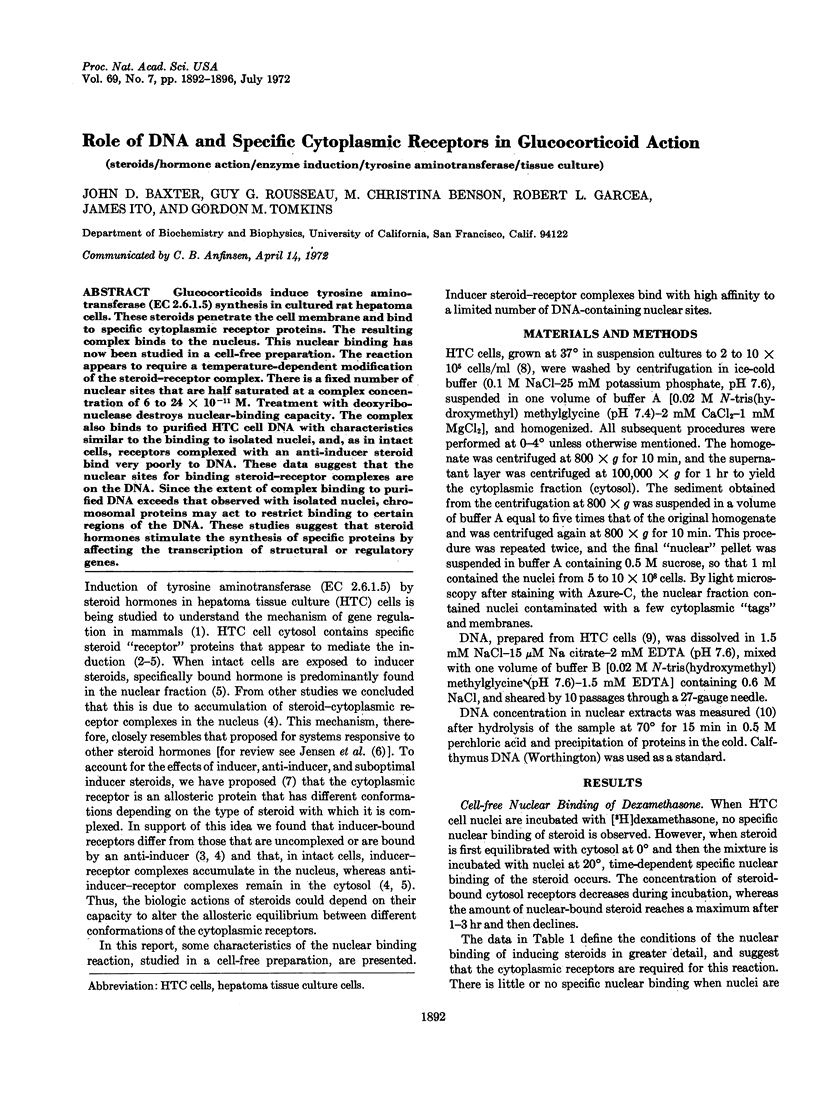
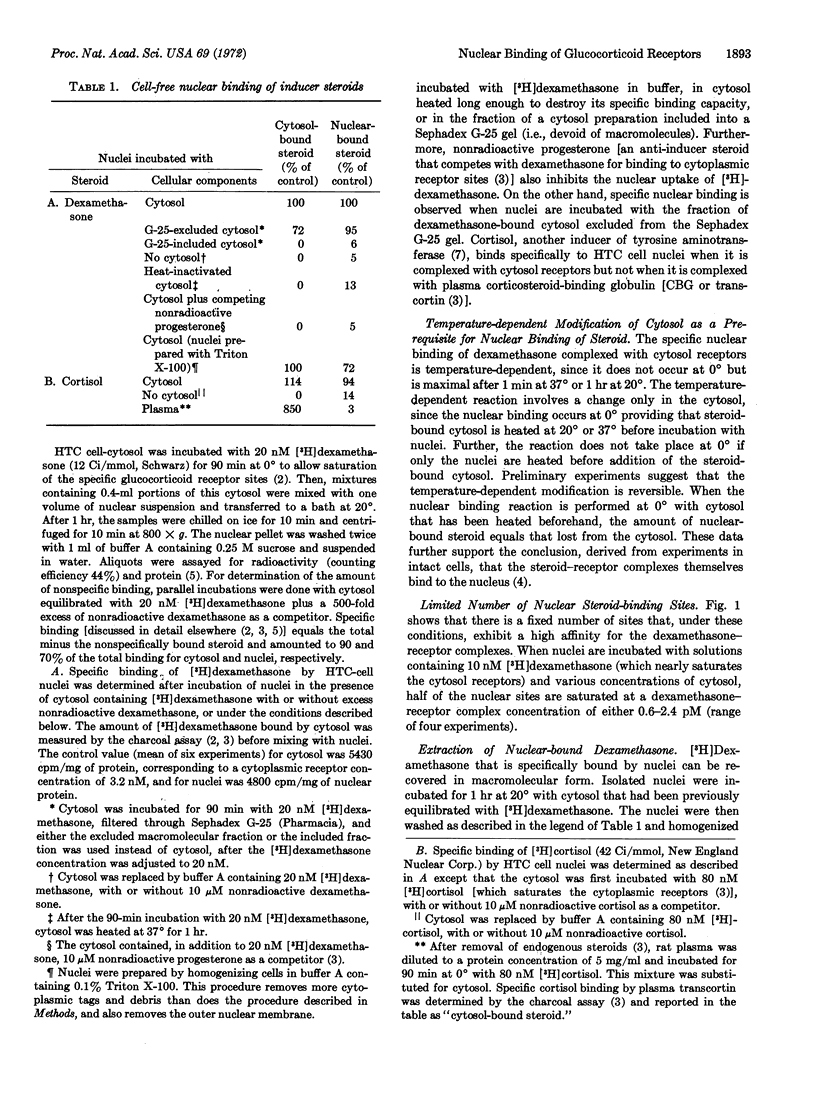
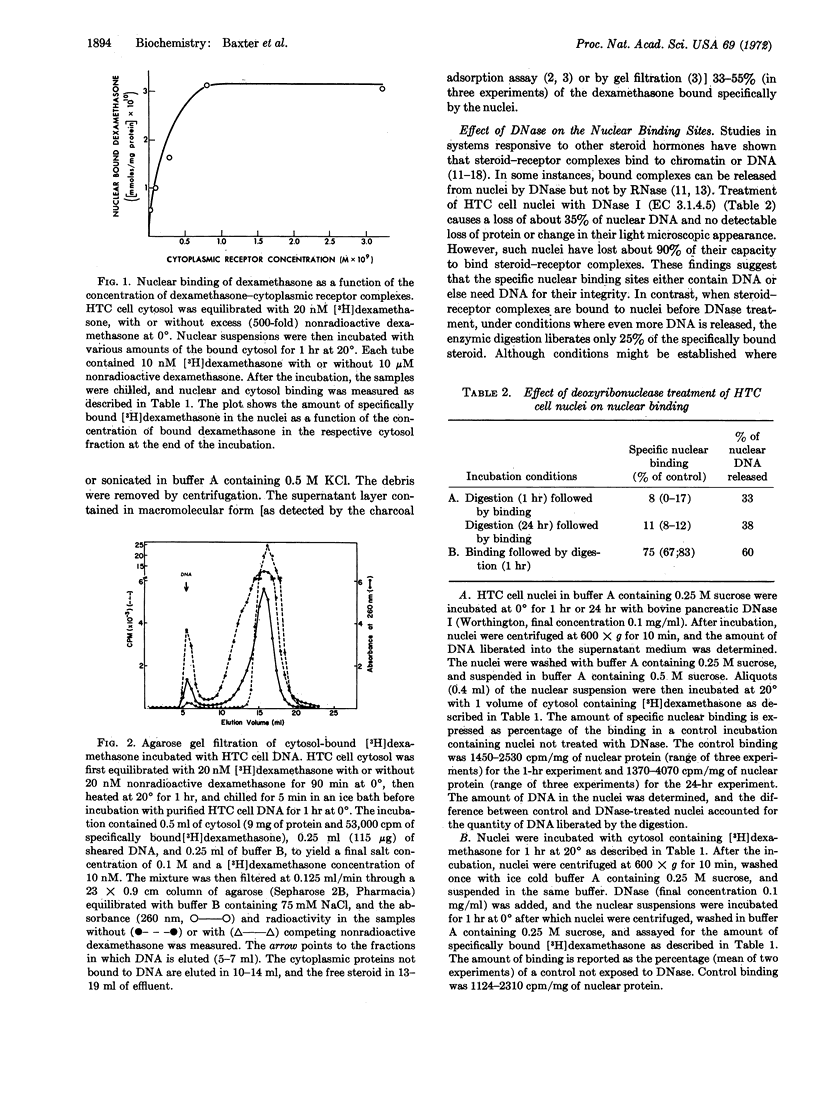
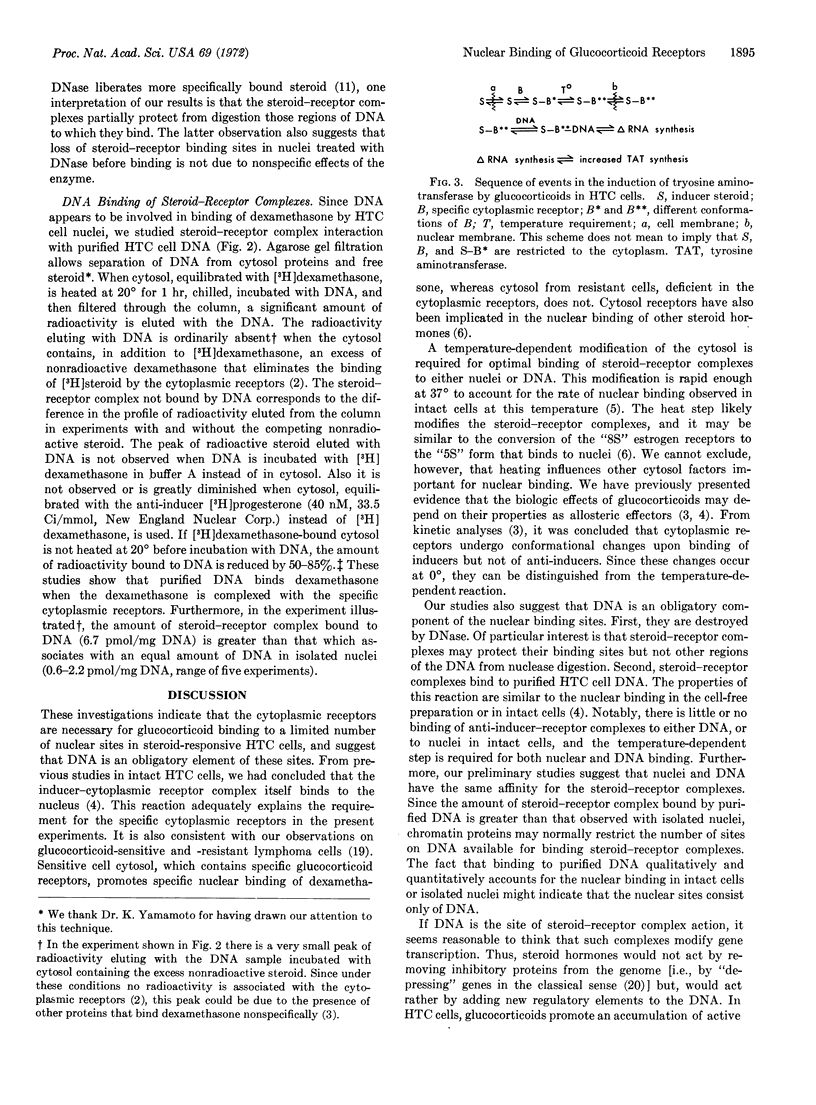
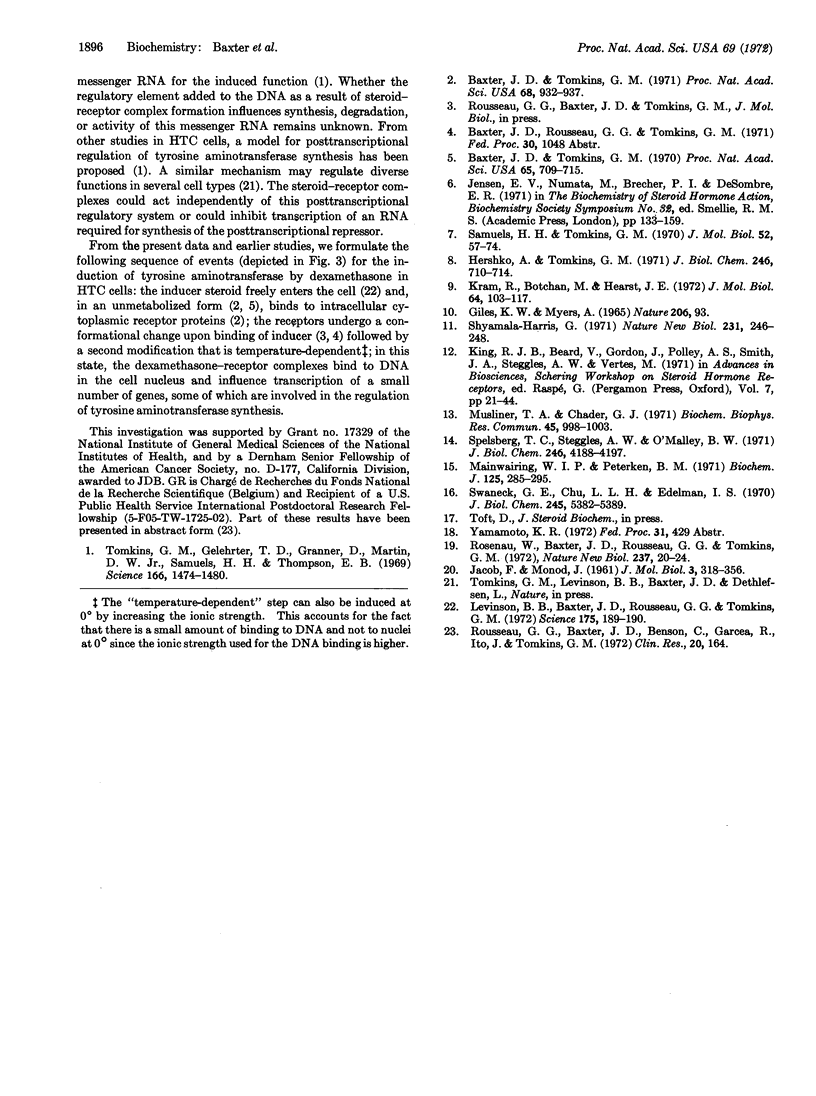
Selected References
These references are in PubMed. This may not be the complete list of references from this article.
- Baxter J. D., Tomkins G. M. Specific cytoplasmic glucocorticoid hormone receptors in hepatoma tissue culture cells. Proc Natl Acad Sci U S A. 1971 May;68(5):932–937. doi: 10.1073/pnas.68.5.932. [DOI] [PMC free article] [PubMed] [Google Scholar]
- Baxter J. D., Tomkins G. M. The relationship between glucocorticoid binding and tyrosine aminotransferase induction in hepatoma tissue culture cells. Proc Natl Acad Sci U S A. 1970 Mar;65(3):709–715. doi: 10.1073/pnas.65.3.709. [DOI] [PMC free article] [PubMed] [Google Scholar]
- Harris G. S. Nature of oestrogen specific binding sites in the nuclei of mouse uteri. Nat New Biol. 1971 Jun 23;231(25):246–248. doi: 10.1038/newbio231246a0. [DOI] [PubMed] [Google Scholar]
- Hershko A., Tomkins G. M. Studies on the degradation of tyrosine aminotransferase in hepatoma cells in culture. Influence of the composition of the medium and adenosine triphosphate dependence. J Biol Chem. 1971 Feb 10;246(3):710–714. [PubMed] [Google Scholar]
- JACOB F., MONOD J. Genetic regulatory mechanisms in the synthesis of proteins. J Mol Biol. 1961 Jun;3:318–356. doi: 10.1016/s0022-2836(61)80072-7. [DOI] [PubMed] [Google Scholar]
- Jensen E. V., Numata M., Brecher P. I., Desombre E. R. Hormone-receptor interaction as a guide to biochemical mechanism. Biochem Soc Symp. 1971;32:133–159. [PubMed] [Google Scholar]
- Kram R., Botchan M., Hearst J. E. Arrangement of the highly reiterated DNA sequences in the centric heterochromatin of Drosophila melanogaster. Evidence for interspersed spacer DNA. J Mol Biol. 1972 Feb 28;64(1):103–117. doi: 10.1016/0022-2836(72)90323-3. [DOI] [PubMed] [Google Scholar]
- Levinson B. B., Baxter J. D., Rousseau G. G., Tomkins G. M. Cellular site of glucocorticoid-receptor complex formation. Science. 1972 Jan 14;175(4018):189–190. doi: 10.1126/science.175.4018.189. [DOI] [PubMed] [Google Scholar]
- MASTER R. W. POSSIBLE SYNTHESIS OF POLYRIBONUCLEOTIDES OF KNOWN BASE-TRIPLET SEQUENCES. Nature. 1965 Apr 3;206:93–93. doi: 10.1038/206093b0. [DOI] [PubMed] [Google Scholar]
- Mainwaring W. I., Peterken B. M. A reconstituted cell-free system for the specific transfer of steroid--receptor complexes into nuclear chromatin isolated from the rat ventral prostate gland. Biochem J. 1971 Nov;125(1):285–295. doi: 10.1042/bj1250285. [DOI] [PMC free article] [PubMed] [Google Scholar]
- Musliner T. A., Chader G. J. A role for DNA in the formation of nuclear estradiol-receptor complex in a cell-free system. Biochem Biophys Res Commun. 1971 Nov;45(4):998–1003. doi: 10.1016/0006-291x(71)90436-0. [DOI] [PubMed] [Google Scholar]
- Rosenau W., Baxter J. D., Rousseau G. G., Tomkins G. M. Mechanism of resistance to steroids: glucocorticoid receptor defect in lymphoma cells. Nat New Biol. 1972 May 3;237(70):20–24. doi: 10.1038/newbio237020a0. [DOI] [PubMed] [Google Scholar]
- Samuels H. H., Tomkins G. M. Relation of steroid structure to enzyme induction in hepatoma tissue culture cells. J Mol Biol. 1970 Aug 28;52(1):57–74. doi: 10.1016/0022-2836(70)90177-4. [DOI] [PubMed] [Google Scholar]
- Spelsberg T. C., Steggles A. W., O'Malley B. W. Progesterone-binding components of chick oviduct. 3. Chromatin acceptor sites. J Biol Chem. 1971 Jul 10;246(13):4188–4197. [PubMed] [Google Scholar]
- Swaneck G. E., Chu L. L., Edelman I. S. Stereospecific binding of aldosterone to renal chromatin. J Biol Chem. 1970 Oct 25;245(20):5382–5389. [PubMed] [Google Scholar]
- Tomkins G. M., Gelehrter T. D., Granner D., Martin D., Jr, Samuels H. H., Thompson E. B. Control of specific gene expression in higher organisms. Expression of mammalian genes may be controlled by repressors acting on the translation of messenger RNA. Science. 1969 Dec 19;166(3912):1474–1480. doi: 10.1126/science.166.3912.1474. [DOI] [PubMed] [Google Scholar]


